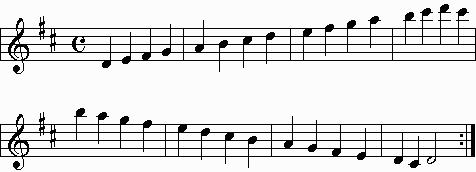
Soloing in D
In This Lesson We Look At Soloing in the Key of D major
Hi, my name is Teague and thanks for checking out my page on soloing in D. First up the video to the right will change very soon with a video to go with material below. The video for now is in the key of D major and is a cover of a One Republic song that a student and myself did.
The first thing we need to know about soloing over a song or progression (or chord for that matter) is knowing the key it belongs to.
In some cases the chord that starts the song is the key of the song as is the case with the One Republic song!
D major scale
Let's start by looking at the key of D major and the D major scale. Building a scale on one string is not the most efficient way to play a scale, however it is a great way to see the relationship between notes and more specifically the whole and half steps.
To the right is the D major scale built with the formula:
W W H W W W H


- Start on open D string
- Whole step to E
- Whole step to F#
- Half step to G
- Whole step to A
- Whole step to B
- Whole step to C#
- Half step to D
So when you follow the major scale formula W W H W W W H the D major scale will have two sharps (F# and C#) and this means the key of D major has the same two sharps.
D major in 9th Position
9th position means your index finger plays all notes on 9th fret, middle finger plays all notes on 10th fret, etc.
Also note that the staff below doesn't have the sharp (#) signs in front of the F's and C's. This example shows a key signature and two sharps represents the key of D major. Also the relative minor of D which is B minor but more on that later.
So the key signature is shown between the clef and the time signature and in the Key of D you can see a sharp sign on the top line (F) and the 3rd space (C) so we will play all F and C's as sharps regardless where they fall on the staff.



The notes on the staff start on D and climb to the high E (12th fret of high E string) but when they come back down you will see that low C# played as the second last note.
D major Pentatonic in 9th Position
A major pentatonic scale is a major scale missing the 4th and 7th degree (note). So in the case of the D major scale we will remove the G (4th) and C# (7th).



Jam Track
So as you begin to solo over the jam track start with the D major pentatonic scale and play up and down with quarter notes, eighth notes, eighth note triplets and sixteenths.
Some other things to think about when you solo:
- Repetition
- Theme and Variation
- Use space/silence (take your time)
- Dynamics (loud and soft)
The above jam track was created from a new tripfuse song (my band) and is in the key of B minor. B minor is the relative minor of D major which means they are the same key. The difference is the order of the chords. Where a song or progression in the key of D major would quite often start on a D chord, a song or progression in the key of B minor would likely start on a B minor chord. Either way we will use the same scales. In other words, if you had played the notes from the D major scale from B to B you would have played a B minor scale and if you had played the notes of the D major pentatonic from B to B you would have played B minor pentatonic.
How to Solo and Improvise Series
FREE 3 Part Series on Learning How to Improvise and Create Great Solos
Register to Get 3 Part Series for FREE
Register now for this Free 3 part series! You will get an email in moments to let you into part 1.
![]() We value your privacy and would never spam you
We value your privacy and would never spam you
